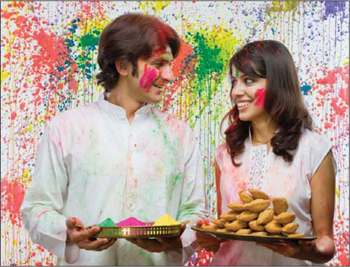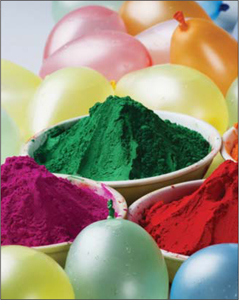
Holi
Splashed with Colors of Friendship
Holi is wild and raucous, a frolic of friendly playfulness. During Holi, India’s streets are overtaken by crowds awash with colored powder. Not only clothes, but faces, arms and hair are smeared and sprayed with every color of the rainbow. People sing, dance, play, hug each other and smile with such child-like joy that it makes one wonder where so much happiness comes from! No religious festival in the world compares to Holi in terms of engaging young and old alike. It is a celebration of love, forgiveness, hope and just plain fun.§
What is Holi?§
Holi is a community’s exuberant expression of joy to welcome the warmth of spring. In a reflection of nature’s abundance, Hindus celebrate with bursts of color, camaraderie and shared abandon. It begins on Purnima, full moon day, in the Hindu month of Phalguni (February/March) and lasts for as long as 16 days. §
How does the festival start?§
Many communities create a central bonfire on the night before Holi, starting with kindling and logs and adding organic debris as they clean up their property. The fire symbolizes the torching of negative or troublesome experiences and memories. An effigy of Holika, a demoness personifying negativity, is consigned to the flames, and freshly harvested barley and oats are offered. The embers are collected to light sacred fires, and the ashes are used to mark the forehead as a blessing. §
When does the color fun begin?§
On the day of Holi, people celebrate by playing, dancing and running in the streets. Water pistols are filled with colored water and squirted on family, friends and strangers alike. Dye powders and water balloons are a big part of the play. The wise wear old clothes, usually white, in anticipation of the mess! Virtually anything goes, including humor, practical jokes and teasing—all excused with the saying, “Don’t mind, it’s Holi!” (Hindi: Bura na mano, Holi hai.) Men are at the playful mercy of women, who dance with them. Especially in North India, people celebrate with abandon, even splashing color on their homes as a prelude to the more sober custom of renewing the paint with shell-based white. Deities and images of ancestors are hand-painted and placed in beautiful altars. Dramatic events feature devotional songs and the retelling of the love epic of Radha and Krishna. Bonds are renewed, particularly among in-laws and the extended family. Etiquette on Holi requires that one accept all overtures with an open heart, burying grievances to begin relationships afresh. People of all walks of life mingle and greet, applying vermilion on each other’s foreheads in an uninhibited exchange of goodwill. §
What are the delicacies of this festival?§
Special sweet and savory treats including mathri, puran poli and vadai are made. Many communities make an intoxicating, cooling drink, called thandai, made of purified water, sugar, seeds of watermelon, muskmelon and lotus, along with nuts, cardamom, fennel, white pepper, saffron and rose petals.§
Tidbits About Holi
![]() Love, positive values and goodness are celebrated on Holi. Their triumphs over divisiveness and negative forces have been reinforced in legends, such as that of Holika and her brother Prahlad. The famous king Hiranyakashipu had earned a boon that made him virtually indestructible. Blinded by this power, he thought he was God, the only being worthy of worship. His young son Prahlad was devoted to Lord Vishnu and refused to obey his father. Infuriated, the king devised the cruelest punishments. In one attempt, Prahlad’s evil aunt Holika, who possessed the power to withstand fire, tricked him into climbing a burning pyre with her. Prahlad’s love for true Divinity protected him from the flames. Holika burned while Prahlad lived. The bonfire of Holi is symbolic of this victory of good over evil. §
Love, positive values and goodness are celebrated on Holi. Their triumphs over divisiveness and negative forces have been reinforced in legends, such as that of Holika and her brother Prahlad. The famous king Hiranyakashipu had earned a boon that made him virtually indestructible. Blinded by this power, he thought he was God, the only being worthy of worship. His young son Prahlad was devoted to Lord Vishnu and refused to obey his father. Infuriated, the king devised the cruelest punishments. In one attempt, Prahlad’s evil aunt Holika, who possessed the power to withstand fire, tricked him into climbing a burning pyre with her. Prahlad’s love for true Divinity protected him from the flames. Holika burned while Prahlad lived. The bonfire of Holi is symbolic of this victory of good over evil. §
![]() Legend has it that Krishna noticed one day how much lighter Radha’s complexion was than His own. His mother playfully suggested that He smear Radha’s cheeks with color to make Her look like Him, which Krishna did. The strong-willed Radha gleefully retaliated, and a merry chaos ensued. Another legend has it that Krishna celebrated this festival with His friends and the gopis. They danced and frolicked, filling the air with color in a joyous welcome of spring. §
Legend has it that Krishna noticed one day how much lighter Radha’s complexion was than His own. His mother playfully suggested that He smear Radha’s cheeks with color to make Her look like Him, which Krishna did. The strong-willed Radha gleefully retaliated, and a merry chaos ensued. Another legend has it that Krishna celebrated this festival with His friends and the gopis. They danced and frolicked, filling the air with color in a joyous welcome of spring. §
![]() The festive dancing and camaraderie create the perfect environment for matrimonial alliances. Young people find mates, and families formally seal marital agreements during these days.§
The festive dancing and camaraderie create the perfect environment for matrimonial alliances. Young people find mates, and families formally seal marital agreements during these days.§
Fact & Fiction
FACT: Hindus worship and celebrate the Divine with unparalleled variety and fervor. Dance, song, prayer, meditation, processions, pilgrimage, bathing, painting, symbols and rituals are all valid ways of connecting with Divinity. This is living testimony to the existence of many paths within this ancient faith, all leading to God. Each person finds his own path among the many laid out by gurus and sages. To the Hindu, spiritual life is meant to be lived joyously, as Holi demonstrates. §
FICTION: Hinduism is rich with stories of the Gods and their wives. Yet, on a deeper, philosophical level, it is widely regarded as a fiction that the Gods are married. The Supreme Being and the Gods are neither male nor female and are therefore not married.§
Making Safe, Natural Colors
Dyes made of toxic chemicals are too often used during Holi. The food-based recipes below, along with edible food coloring, offer safe alternatives for all colors.§
RED: Soak red pomegranate rind in water overnight. A pinch of edible gypsum mixed with turmeric powder in water gives a bright red. Soak red hibiscus flowers in water overnight. §
YELLOW: Turmeric powder makes a terrific yellow. §
BROWN: Soak betel nut in water overnight and dilute as necessary. Or boil tea or coffee in water. §
PURPLE: Boil blueberries in an iron vessel and let stand overnight. §
MAGENTA: Slice or grate one beet root. Leave overnight in water. Dilute as needed for different shades.§
GREEN: Purée spinach, coriander or mint leaves in water. Strain and use. §


